Developing a Metropolitan-Wide Urban Forest Strategy for a Large, Expanding and Densifying Capital City: Lessons from Melbourne, Australia
Abstract
:1. Introduction
2. Background
2.1. Current Context for Melbourne
2.2. Developing the ‘Resilient Melbourne’ Strategy
3. Developing a Metropolitan-Wide Urban Forest Strategy
3.1. Mapping and Modelling to Inform Priorities
3.1.1. Mapping Metropolitan Melbourne’s Urban Forest
3.1.2. Habitat Connectivity
3.1.3. Correlations between the Urban Forest and Heat Vulnerability
3.2. Governance Arrangements
3.3. Concurrent Consultation with Stakeholders
- Establish the current status of the urban forest and associated management issues;
- Develop the vision and goals;
- Develop the critical strategic areas that the strategy would address;
- Identify technical evidence to guide the strategy;
- Frame and develop the draft strategy.
- Twenty-six LGAs contributed their tree asset inventories of street trees and open space trees. While these databases vary in size and scope, these datasets were used to help determine the monetised value of these assets including the economic savings in the form of pollution removal, carbon storage, carbon sequestration, and avoided water run-off. The datasets also helped calculate the cost of replacing these assets with similar trees based on size, species, health and location.
- BirdLife Australia supplied bird atlas data. Using the urban forest canopy cover mapping layer with bird atlas data and other important datasets (such as ecological vegetation classes), enabled the modelling of different levels of connectivity and landscape permeability for different bird species and bird groups.
- Thirty organisations, including 27 LGAs and three major public land managers (Parks Victoria, Melbourne Water and VicRoads) supplied their operational costs relating to the establishment, management and maintenance of vegetation.
- Tree purchasing, planting and maintenance costs were supplied by organisations such Council Arborists Victoria, Nursery and Garden Industry Victoria and public land management agencies to inform estimates of costs for future canopy targets.
4. Vision, Goals and Actions of Living Melbourne
- Healthy people: Protect and increase access to nature, green space and canopy cover, to reduce heat exposure, and improve mental and physical wellbeing.
- Abundant nature: Protect and extend habitat connectivity and corridors to enhance biodiversity.
- Natural infrastructure: Protect and increase vegetation on public and private land, in order to cool urban areas, retain water in the soils, reduce flood risk and increase water and air quality.
- Action 1: Protect and restore habitats, and increase ecological connectivity of all types between streetscapes, conservation reserves, riparian and coastal areas, open spaces and other green infrastructure across metropolitan Melbourne.
- Action 2: Set urban canopy and understorey targets for each metropolitan region, and decide on a clear and consistent method for long-term monitoring and evaluation of the quality and extent of the urban forest.
- Were calculated based on vegetation in the existing urban area at 2015.
- Applied to all land (public and private) in each region.
- Recommended increases each decade.
- Were supported by principles, including no net loss of tree or shrub cover on public and private urban land in each metropolitan region.
- Action 3: Strengthen planning and development standards and relevant guidelines to increase the greening of the private realm.
- Action 4: Encourage collaboration between sectors and regions, to protect and expand the urban forest by strengthening existing regional partnerships, and establishing new ones, and by accelerating greening efforts on private land.
- Action 5: Equip practitioners to protect and enhance the urban forest by building on existing resources and creating a shared toolkit to facilitate implementation of best practices.
- Action 6: Establish a set of funding and financing options to suit different types of urban forest action.
5. Discussion
5.1. Key Processes and Enabling Conditions That Facilitated Success
- The City of Melbourne had developed a world-class urban forest strategy.
- Thirteen LGAs (including City of Melbourne) had already developed (or were developing) municipal urban forest strategies and other metropolitan LGAs had relevant urban greening and open space related policies or strategies.
- Greening the West had been working as an alliance of organisations working toward a common agenda and was in the process of planting one million trees.
- Melbourne Water was developing the Healthy Waterways Strategy 2018–2028 [55], a strategy shared by Melbourne Water, state and local governments, water corporations and the community. It covers the rivers, creeks, estuaries and wetlands of the Port Phillip and Westernport region, providing a single framework to protect and improve the waterways’ environmental, social, economic and cultural values for the community.
- The Nature Conservancy had recently scoped the potential for a city-wide biodiversity strategy for Melbourne.
5.2. Challenges, Limitations and Critical Areas to Build on for Implementing the Strategy
- A critical element of the strategy included the science associated with the vegetation mapping and the resultant use of the vegetation mapping in urban heat island analysis and models for some elements of biodiversity. Although it was considered that the input data to create the vegetation were of good quality and that there was a high level of accuracy, the large geographic area of metropolitan Melbourne meant that there were variations in the dates and times of the satellite imagery and LiDAR datasets, and the DTM and DSM resolution. Additional technical analysis would have enhanced the strategy, although these remain areas that could be readily undertaken using the base vegetation mapping.Most municipalities have biodiversity-related policy, strategy and or detailed plans. A granular analysis of a larger suite of metropolitan biodiversity values and threats, using available local government biodiversity-related strategy and existing Victorian Government datasets, could have provided more detailed direction for biodiversity benefits and habitat connectivity opportunities. Acknowledging the continuing need for this activity, Action 1 in the strategy provides a step-by-step approach for improving biodiversity and connectivity.The Living Melbourne canopy analysis, undertaken using the software eCognition Essentials (Trimble Geospatial), provided tenure-neutral canopy mapping of 639,124 hectares of urban, peri-urban and rural land across the Melbourne metropolitan area. While the canopy mapping identified vegetation distribution and height, future analysis that could better differentiate different tree types (e.g., deciduous, eucalyptus, broadleaf trees, etc.) would be useful for finer scale conservation planning and assist the further prioritisation of on-ground urban greening locations.Sixteen local government street and park tree inventories were gathered during the development of the strategy and were most helpful to inform some research related to the financial value of such assets. These inventories could also be used to inform biodiversity connectivity mapping and identify where opportunities exist to provide good heat mitigation walking-corridors. In addition, such inventories, combined with the values available from the multi-spectral satellite imagery and canopy mapping might assist to validate remote species identification.
- Collaboration was sought with land managers (including urban development industry representatives) and policy makers and not directly with the general public. It was agreed by the Senior Reference Group that LGAs, being the closest tier of government to the community should be relied upon to engage with relevant community stakeholders about Living Melbourne. Had significantly greater resources been available, direct community engagement at some level could have been advantageous. It should be acknowledged as part of the ongoing implementation of the strategy that public land management practitioners, in particular LGAs, will continue to closely engage with the public.
- LGAs as key stakeholders and other major land management organisations (e.g., water authorities and public land managers) were specifically targeted as key endorsers as a subset of the wider consultation undertaken. Suggestions by some academic commentators [51,52] that the views of other key stakeholders (e.g., transport, health) were not sought is erroneous.
- The rationale for the targets proposed in Living Melbourne is articulated above. An alternative target strategy would have been for all regions to reach 30% canopy by 2050 rather than the range of targets that were offered. This would have lent an increased element of regional equity for residents to benefit from ambitious canopy targets. It would also have required a much more aggressive canopy enhancement approach for some regions each decade. Most notably the Western Region, and to a lesser extent the Northern and Inner Regions, would have had to have increased canopy beyond the 5 percent increase per decade. It is uncertain whether this would be achievable.
- Endorsing authorities were asked to support Living Melbourne’s vision, goals and actions and commit to work in partnership with the other endorsing organisations towards its implementation. More could have been requested of endorsing organisations, such as a specific commitment of financial and other resources.
5.3. Implementation Post Strategy Development
6. Conclusions
Author Contributions
Funding
Data Availability Statement
Acknowledgments
Conflicts of Interest
References
- Oke, C.; Bekessy, S.A.; Frantzeskaki, N.; Bush, J.; Fitzsimons, J.A.; Garrard, G.E.; Grenfell, M.; Harrison, L.; Hartigan, M.; Callow, D.; et al. Cities should respond to the biodiversity extinction crisis. NPJ Urban Sustain. 2021, 1, 11. [Google Scholar] [CrossRef]
- McDonald, R.; Kroeger, T.; Boucher, T.; Longzhu, W.; Salem, R.; Adams, J.; Bassett, S.; Edgecomb, M.; Garg, S. Planting Healthy Air: A Global Analysis of the Role of Urban Trees in Addressing Particulate Matter Pollution and Extreme Heat; The Nature Conservancy: Arlington, VA, USA, 2016. [Google Scholar]
- Threlfall, C.G.; Mata, L.; Mackie, J.A.; Hahs, A.K.; Stork, N.E.; Williams, N.S.; Livesley, S.J. Increasing biodiversity in urban green spaces through simple vegetation intervention. J. Appl. Ecol. 2017, 54, 1874–1883. [Google Scholar] [CrossRef] [Green Version]
- Shanahan, D.F.; Fuller, R.A.; Bush, R.; Lin, B.B.; Gaston, K.J. The health benefits of urban nature: How much do we need? BioScience 2015, 65, 476–485. [Google Scholar] [CrossRef] [Green Version]
- Díaz, S.; Pascual, U.; Stenseke, M.; Martín-López, B.; Watson, R.T.; Molnár, Z.; Hill, R.; Chan, K.M.A.; Baste, I.A.; Brauman, K.A.; et al. Assessing nature’s contributions to people. Science 2018, 359, 270–272. [Google Scholar] [CrossRef] [Green Version]
- Mumaw, L.; Bekessy, S. Wildlife gardening for collaborative public–private biodiversity conservation. Austral. J. Environ. Manag. 2017, 24, 242–260. [Google Scholar] [CrossRef]
- United Nations. Revision of the World Urbanization Prospects: 2018; United Nations Department of Economic and Social Affairs: New York, NY, USA, 2018. [Google Scholar]
- Jim, C.Y.; Konijnendijk van den Bosch, C.; Chen, W.Y. Acute challenges and solutions for urban forestry in compact and densifying cities. J. Urban Plann. Dev. 2018, 144, 04018025. [Google Scholar] [CrossRef]
- Haaland, C.; Konijnendijkvan den Bosch, C. Challenges and strategies for urban green-space planning in cities undergoing densification: A review. Urban For. Urban Green. 2015, 14, 760–771. [Google Scholar] [CrossRef]
- Saunders, A.; Duncan, J.; Hurley, J.; Amati, M.; Caccetta, P.; Chia, J.; Boruff, B. Leaf my neighbourhood alone! Predicting the influence of densification on residential tree canopy cover in Perth. Landsc. Urban Plan. 2020, 199, 103804. [Google Scholar] [CrossRef]
- Ordóñez, C.; Threlfall, C.G.; Livesley, S.J.; Kendal, D.; Fuller, R.A.; Davern, M.; van der Ree, R.; Hochuli, D.F. Decision-making of municipal urban forest managers through the lens of governance. Environ. Sci. Pol. 2020, 104, 136–147. [Google Scholar] [CrossRef]
- Ordóñez, C.; Duinker, P. An analysis of urban forest management plans in Canada; Implications for urban forest management. Landsc. Urban Plan. 2013, 116, 36–47. [Google Scholar] [CrossRef] [Green Version]
- Hinch, R.; Maxwell, E.; Chen, N. A Summary of Current Urban Forest Plans and Metrics; The Nature Conservancy: Arlington, VA, USA, 2018. [Google Scholar]
- ABS. 3105.0.65.001-Australian Historical Population Statistics, 2016; Australian Bureau of Statistics, Commonwealth of Australia: Canberra, Australia, 2019. Available online: https://www.abs.gov.au/AUSSTATS/abs@.nsf/mf/3105.0.65.001 (accessed on 31 October 2020).
- Phelan, K.; Hurley, J.; Bush, J. Land-use planning’s role in urban forest strategies: Recent local government approaches in Australia. Urban Pol. Res. 2019, 37, 215–226. [Google Scholar] [CrossRef]
- Infrastructure Victoria. Growing Victoria’s Potential: The Opportunities and Challenges of Victoria’s Population Growth; Infrastructure Victoria: Melbourne, Australia, 2019. [Google Scholar]
- DELWP. Plan Melbourne 2017–2050; Victorian State Government: Melbourne, Australia, 2017. [Google Scholar]
- Heneghan, L.; Mulvaney, C.; Ross, K.; Umek, L.; Watkins, C.; Westphal, L.M.; Wise, D.H. Lessons learned from Chicago Wilderness—Implementing and sustaining conservation management in an urban setting. Diversity 2012, 4, 74–93. [Google Scholar] [CrossRef] [Green Version]
- VEAC. Metropolitan Melbourne Investigation Final Report; Victorian Environmental Assessment Council: Melbourne, Australia, 2011. [Google Scholar]
- Wahlquist, C. Melbourne ‘World’s Most Liveable City’ for Seventh Year Running. The Guardian. 6 August 2017. Available online: https://www.theguardian.com/australia-news/2017/aug/16/melbourne-worlds-most-liveable-city-for-seventh-year-running (accessed on 31 October 2020).
- Destination Melbourne. Greater Melbourne’s Destination Management Visitor Plan: Executive Summary; Destination Melbourne: Melbourne, Australia, 2018. [Google Scholar]
- Hahs, A.; McDonnell, M.; Holland, K.; Caryl, F. Biodiversity of Metropolitan Melbourne; Prepared for Victorian Environmental Assessment Council by Australian Research Centre for Urban Ecology; Royal Botanic Gardens: Melbourne, Australia, 2009. Available online: https://veac.vic.gov.au/investigations-assessments/previous-investigations/document/getDownload?fid=MjAx (accessed on 31 October 2020).
- Moore, G.M. Taking It to the Streets: Celebrating a Twenty Year History of Treenet—Responding to the Urban Forest Challenge. In Proceedings of the Treenet: 18th National Street Tree Symposium, Adelaide, Australia, 7–8 September 2017; Available online: https://treenet.org/wp-content/uploads/2017/10/Taking-it-to-the-Streets-Responding-to-the-Urban-Forest-Challenge_GM-Moore.pdf (accessed on 31 October 2020).
- Hurley, J.; Saunders, A.; Both, A.; Sun, C.; Boruff, B.; Duncan, J.; Amati, M.; Caccetta, P.; Chia, J. Urban Vegetation Cover Change in Melbourne 2014–2018; Centre for Urban Research, RMIT University: Melbourne, Australia, 2019. [Google Scholar]
- Municipal Association of Victoria. 2019. Available online: http://www.mav.asn.au/ (accessed on 11 December 2019).
- DELWP. Victoria’s Climate Change Adaptation Plan 2017–2020; Victorian Government: Melbourne, Australia, 2016. [Google Scholar]
- DELWP. Protecting Victoria’s Environment: Biodiversity 2037; Victorian State Government: Melbourne, Australia, 2017. [Google Scholar]
- Victorian Government. Victorian Public Health and Wellbeing Plan 2015–2019; Victorian Government: Melbourne, Australia, 2015. [Google Scholar]
- DELWP. Melbourne Open Space Strategy: Ensuring Liveability for Future Generations. Draft for Comment September 2019; Victoria State Government: Melbourne, Australia, 2019. [Google Scholar]
- Greening the West. About Greening the West. Available online: https://greeningthewest.org.au/about/ (accessed on 12 December 2019).
- Zebrowski, C. Acting local, thinking global: Globalizing resilience through 100 Resilient Cities. New Perspect. 2020, 28, 71–88. [Google Scholar] [CrossRef]
- Resilient Melbourne. Resilient Melbourne Strategy; City of Melbourne: Melbourne, Australia, 2016. [Google Scholar]
- McDonald, R.I.; Colbert, M.; Hamann, M.; Simkin, R.; Walsh, B. Nature in the Urban Century: A Global Assessment of Where and How to Conserve Nature for Biodiversity and Human Wellbeing; The Nature Conservancy: Arlington, VA, USA, 2018; Available online: https://www.nature.org/content/dam/tnc/nature/en/documents/TNC_NatureintheUrbanCentury_FullReport.pdf (accessed on 29 September 2020).
- McDonald, R.I.; Mansur, A.V.; Ascensão, F.; Colbert, M.; Crossman, K.; Elmqvist, T.; Gonzalez, A.; Güneralp, B.; Haase, D.; Hamann, M.; et al. Research gaps in knowledge of the impact of urban growth on biodiversity. Nat. Sustain. 2020, 3, 16–24. [Google Scholar] [CrossRef]
- The Nature Conservancy and Resilient Melbourne. Living Melbourne: Our Metropolitan Urban Forest; The Nature Conservancy and Resilient Melbourne: Melbourne, Australia, 2019. [Google Scholar]
- Yan, J.; Zhou, W.; Han, L.; Qian, Y. Mapping vegetation functional types in urban areas with WorldView-2 imagery: Integrating object-based classification with phenology. Urban For. Urban Green. 2018, 31, 230–240. [Google Scholar] [CrossRef]
- City of Melbourne. Urban Forest Strategy: Making a Great City Greener: 2012–2032; City of Melbourne: Melbourne, Australia, 2012. [Google Scholar]
- The Nature Conservancy and Resilient Melbourne. Living Melbourne: Our Metropolitan Urban Forest Technical Report; The Nature Conservancy and Resilient Melbourne: Melbourne, Australia, 2019. [Google Scholar]
- Crooks, K.; Sanjayan, M. Connectivity Conservation; Cambridge University Press: New York, NY, USA, 2006. [Google Scholar]
- Palmer, G.C.; Fitzsimons, J.A.; Antos, M.J.; White, J.G. Determinants of native avian richness in suburban remnant vegetation: Implications for conservation planning. Biol. Conserv. 2008, 141, 2329–2341. [Google Scholar] [CrossRef] [Green Version]
- White, J.G.; Antos, M.J.; Fitzsimons, J.A.; Palmer, G.C. Non-uniform bird assemblages in urban environments: The influence of streetscape vegetation. Lands. Urban Plan. 2005, 71, 123–135. [Google Scholar] [CrossRef]
- Callaghan, C.T.; Major, R.E.; Lyons, M.B.; Martin, J.M.; Kingsford, R.T. The effects of local and landscape habitat attributes on bird diversity in urban greenspaces. Ecosphere 2018, 9, e02347. [Google Scholar] [CrossRef] [Green Version]
- Champness, B.S.; Palmer, G.C.; Fitzsimons, J.A. Bringing the city to the country: Relationships between streetscape vegetation type and bird assemblages in a major regional centre. J. Urban Ecol. 2019, 5, juz018. [Google Scholar] [CrossRef]
- Fraixedas, S.; Lindén, A.; Piha, M.; Cabeza, M.; Gregory, R.; Lehikoinen, A. A state-of-the-art review on birds as indicators of biodiversity: Advances, challenges, and future directions. Ecol. Indic. 2020, 118, 106728. [Google Scholar] [CrossRef]
- Fitzsimons, J.A.; Antos, M.J.; Palmer, G.C. When more is less: Urban remnants support high bird abundance but diversity varies. Pac. Conserv. Biol. 2011, 17, 97–109. [Google Scholar] [CrossRef] [Green Version]
- Coutts, A.M.; Tapper, N.J.; Beringer, J.; Loughnan, M.; Demuzere, M. Watering our cities: The capacity for water sensitive urban design to support urban cooling and improve human thermal comfort in the Australian context. Prog. Phys. Geogr. Earth Environ. 2012, 37, 2–28. [Google Scholar] [CrossRef]
- Tapper, N.; Loughnan, M.; Nicholls, N. Towards management of urban heat stress in urban environments: Recent developments in Melbourne, Victoria. Emerg. Med. Australas. 2010, 22, A11–A12. [Google Scholar]
- DELWP. Melbourne Vegetation and Land Use Cover 2014; Department of Environment, Land, Water and Planning: Melbourne, Australia, 2018. Available online: https://services.land.vic.gov.au/SpatialDatamart/index.jsp (accessed on 12 December 2020).
- Leahy, I. Why We No Longer Recommend a 40 Percent Urban Tree Canopy Goal. Loose Leaf: The Official Blog of American Forests. 2017. Available online: https://www.americanforests.org/blog/no-longer-recommend-40-percent-urban-tree-canopy-goal/ (accessed on 26 September 2018).
- Coenen, L.; Davidson, K.; Frantzeskaki, N.; Grenfell, M.; Håkansson, I.; Hartigan, M. Metropolitan governance in action? Learning from metropolitan Melbourne’s urban forest strategy. Aust. Plan. 2020, 56, 144–148. [Google Scholar] [CrossRef]
- Bush, J.; Coffey, B.; Fastenrath, S. Governing urban greening at a metropolitan scale: An analysis of the Living Melbourne strategy. Aust. Plan. 2020, 56, 95–102. [Google Scholar] [CrossRef]
- Fastenrath, S.; Bush, J.; Coenen, L. Scaling-up nature-based solutions. Lessons from the Living Melbourne strategy. Geoforum 2020, 116, 63–72. [Google Scholar] [CrossRef]
- Dobbs, C.; Kendal, D.; Nitschke, C. The effects of land tenure and land use on the urban forest structure and composition of Melbourne. Urban For. Urban Green. 2013, 12, 417–425. [Google Scholar] [CrossRef]
- Gulsrud, N.M.; Hertzog, K.; Shears, I. Innovative urban forestry governance in Melbourne?: Investigating “green placemaking” as a nature-based solution. Environ. Res. 2018, 161, 158–167. [Google Scholar] [CrossRef]
- Melbourne Water. Healthy Waterways Strategy 2018–2028; Melbourne Water: Melbourne, Australia, 2018. [Google Scholar]
- VPA. Guidelines for Precinct Structure Planning in Melbourne’s Greenfields: Draft for Public Engagement September 2020; Victorian Planning Authority: Melbourne, Australia, 2020. [Google Scholar]
- Ostoić, S.K.; Salbitano, F.; Borelli, S.; Verlič, A. Urban forest research in the Mediterranean: A systematic review. Urban Forest. Urban Green. 2018, 31, 185–196. [Google Scholar] [CrossRef]
- Fastenrath, S.; Coenen, L.; Davidson, K. Urban resilience in action: The Resilient Melbourne Strategy as transformative urban innovation policy? Sustainability 2019, 11, 693. [Google Scholar] [CrossRef] [Green Version]
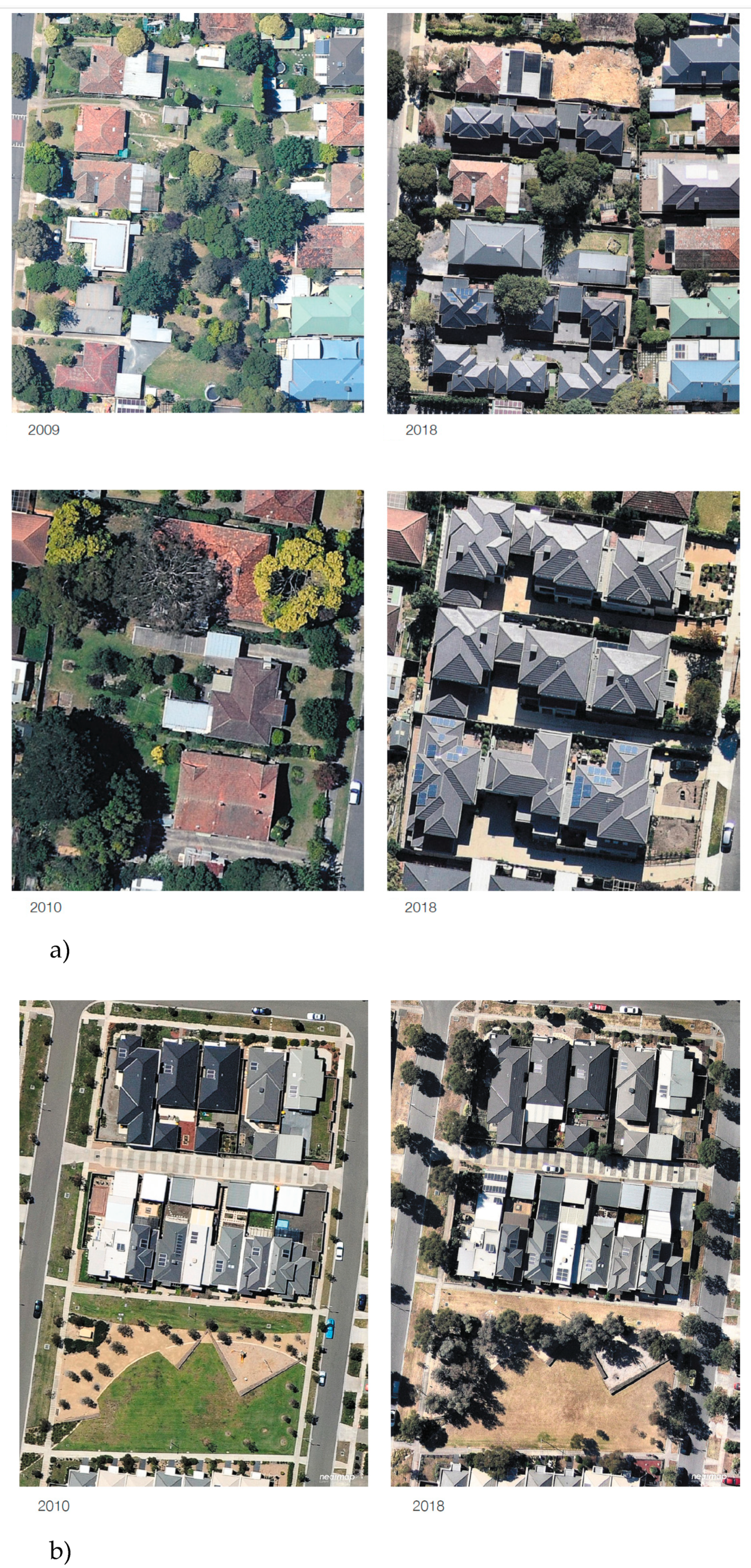
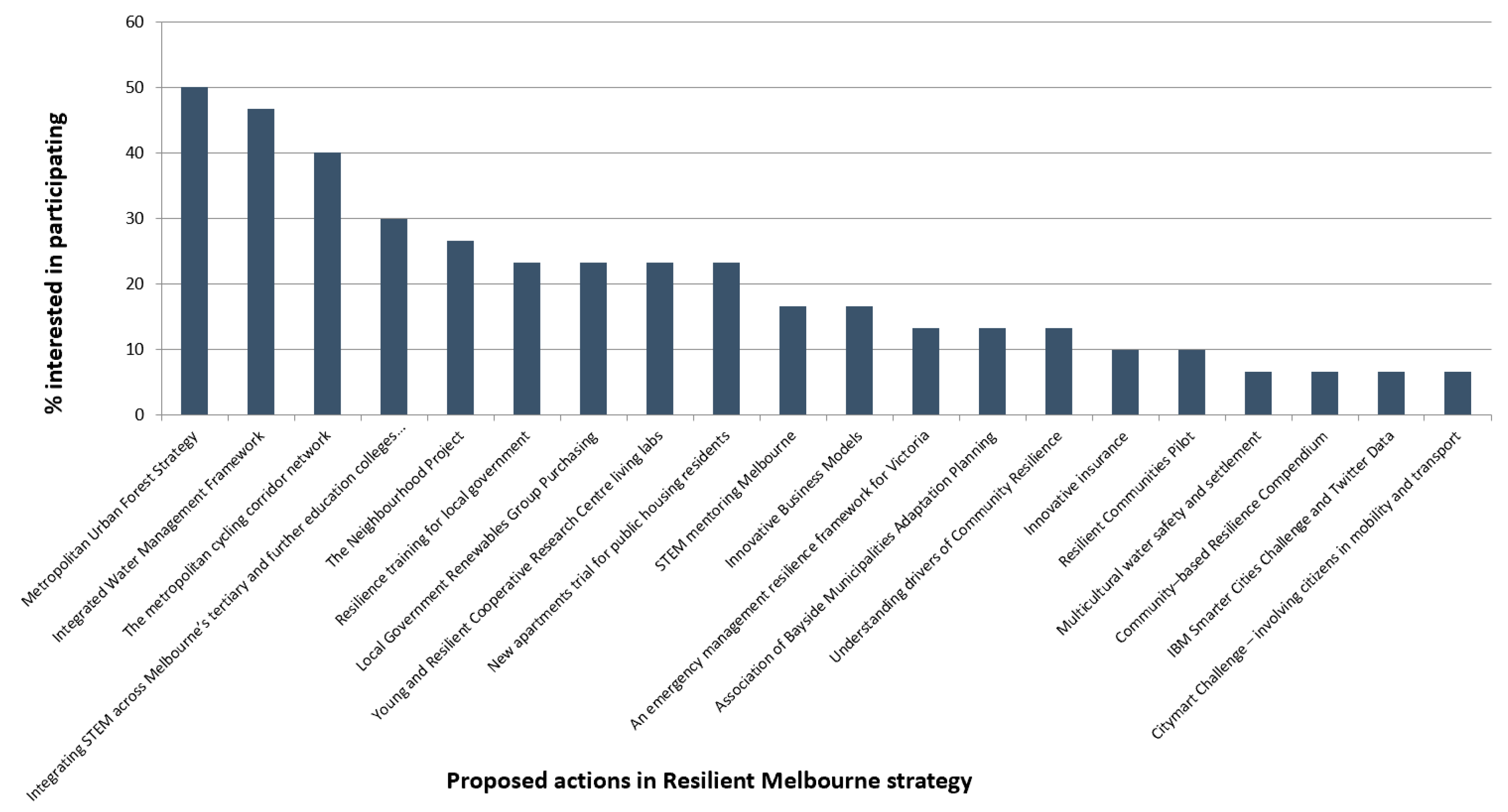
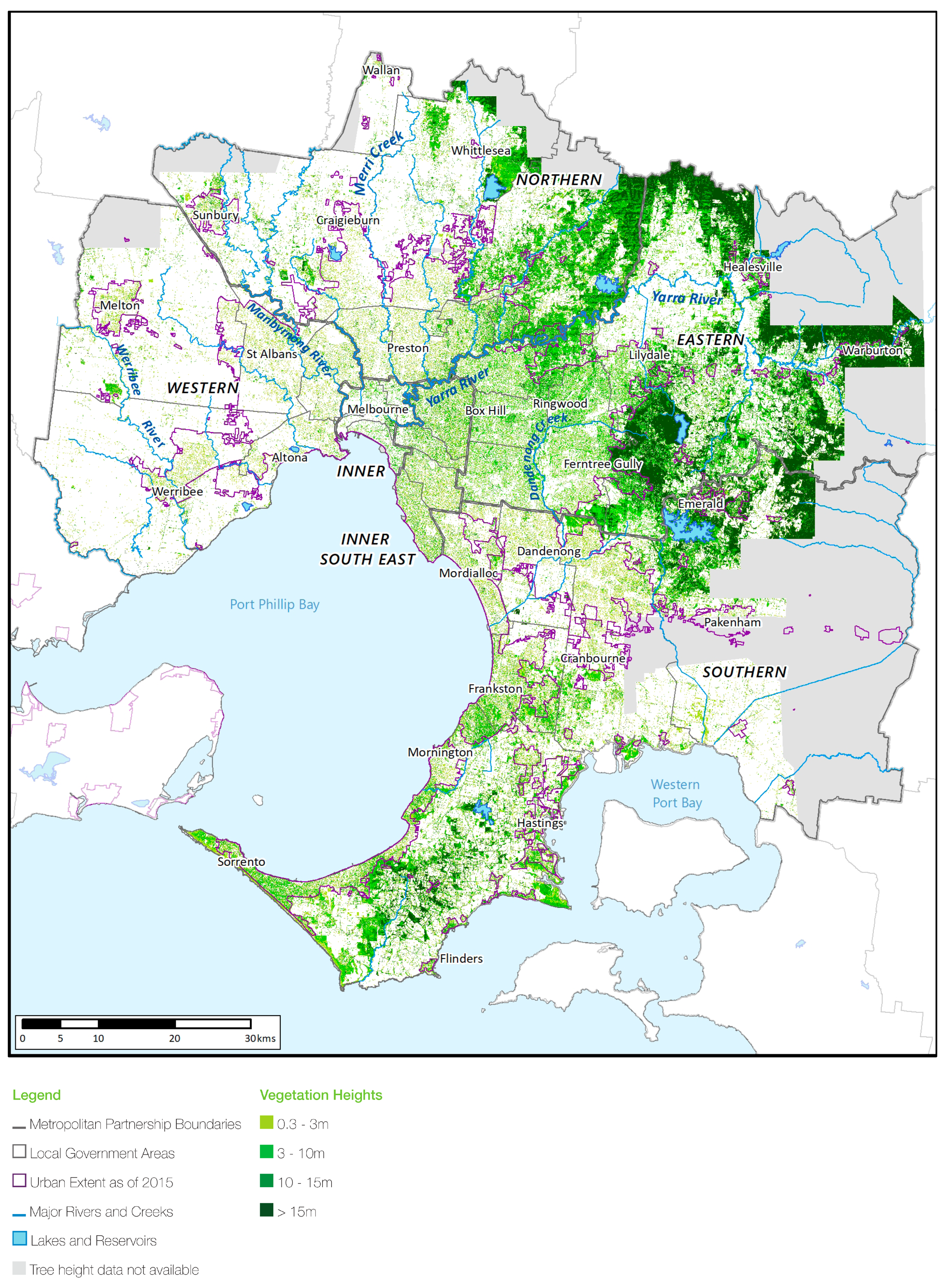

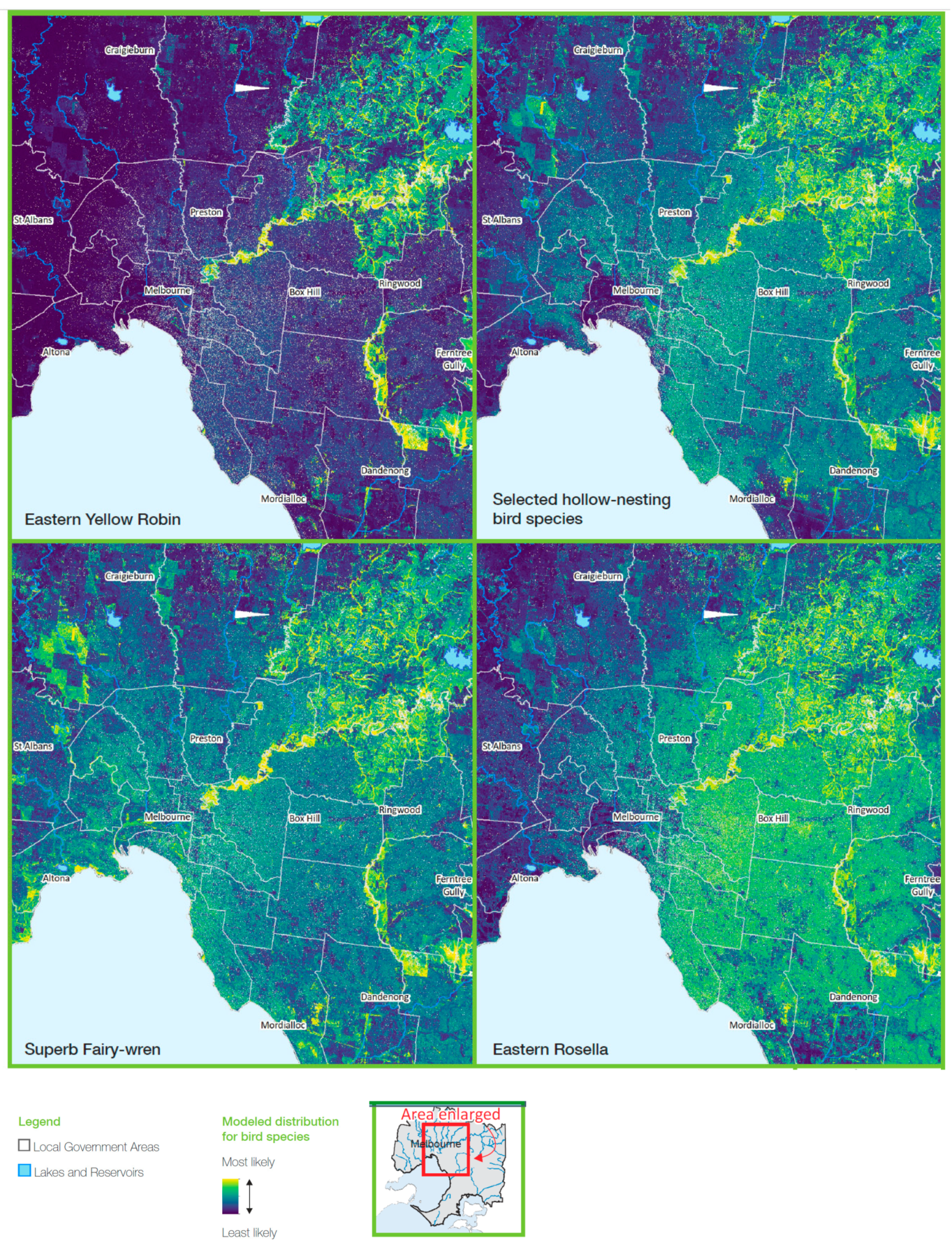
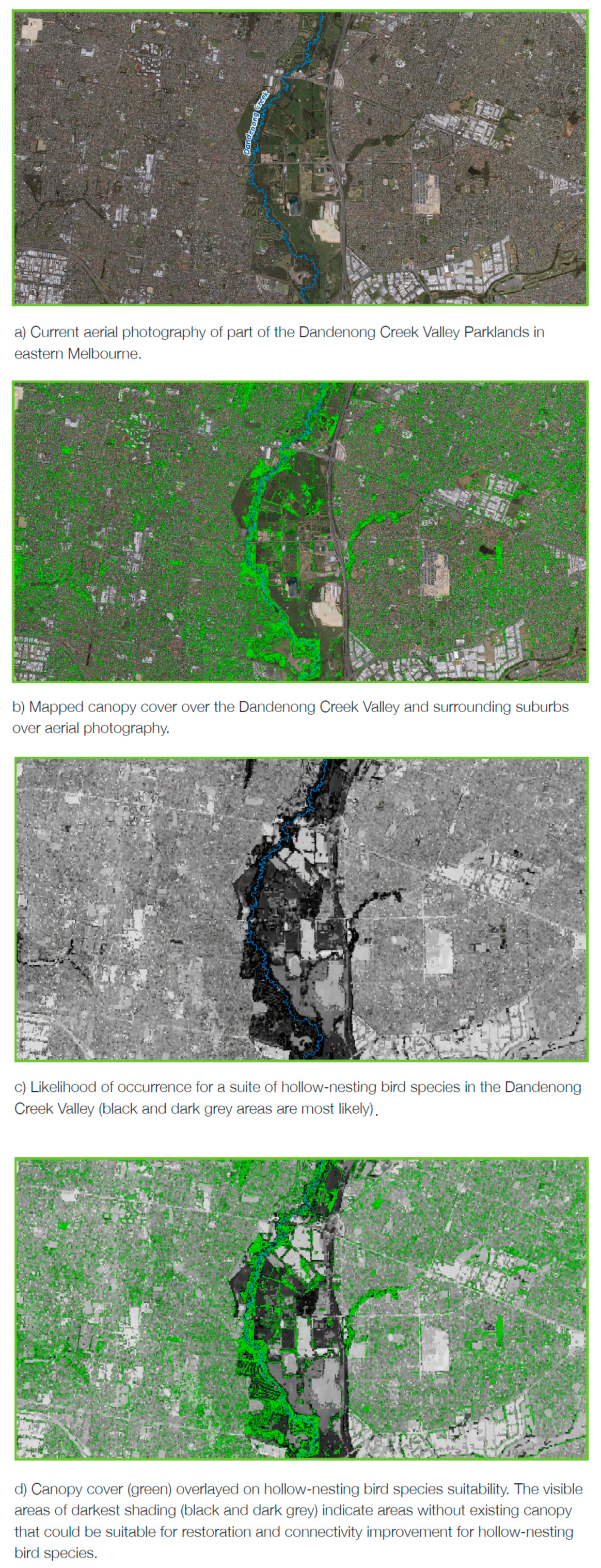

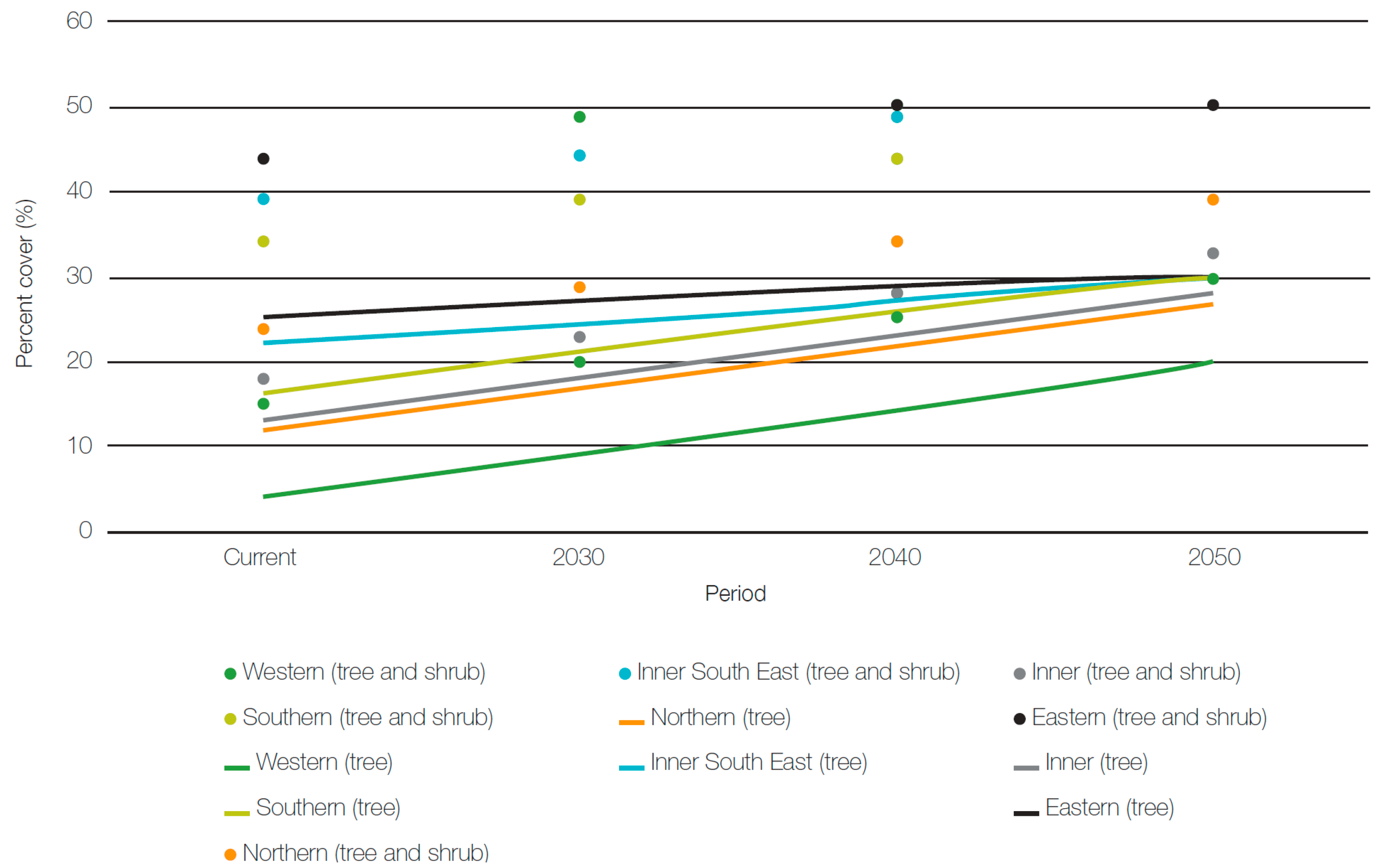
| Local Government | Urban Forest Strategy | Current Total Tree Canopy Cover | Measurable Canopy Cover Target/s (Public Land) | Measurable Canopy Cover Target/s (Private Land) | Overall Canopy Cover Target | Measurable Tree Diversity Target |
|---|---|---|---|---|---|---|
| City of Melbourne | Yes | 11.0% | 40% by 2040 | No more than 5% species, 10% genus, 20% family | ||
| City of Port Phillip | Yes | 22.0% | Yes, individual suburb targets by 2027 | Increase diversity | ||
| City of Yarra | Yes | 17.0% | 21.25% by 2040 | |||
| City of Banyule | Yes | Parks and bushland reserves: 37.0% | Parks: 50%; Streets 75% | Increase by 20% | Increase diversity | |
| City of Darebin | Yes | 9.8% | At least 25% by 2028 | |||
| City of Moonee Valley | In development | 11.0% | ||||
| City of Moreland | Yes | 14.0% | 21.3% by 2050 | Maintain at current 9% by 2050 | 30.3% by 2050 | Street tree planting guide: No more than 40% one family, 15% one genus and 5% one species |
| City of Whittlesea | In development | 19.72% | Yes | Yes | Increase by 20% by 2040 | |
| City of Knox | Street Tree Asset Management Plan | Streets: 22.0% | 25% by 2030 in streetscapes | Improve diversity | ||
| City of Casey | 2009 Revegetation strategy | Remnant vegetation: 7.0% | Native vegetation 30% | |||
| City of Greater Dandenong | Yes | 9.90% | 15% by 2028 | |||
| City of Frankston | Urban Forest Policy | 17.0% | 20% by 2040 | |||
| City of Glen Eira | In development | 12.5% | 14% by 2040 | |||
| City of Monash | Monash Urban Landscape and Canopy Vegetation Strategy | 22.0% | 30% by 2040 | |||
| City of Stonnington | Yes | 25.0% | No more than: 30% of any one family, 20% of any one genus, 10% of any one species | |||
| City of Brimbank | Yes | 6.20% | 50% canopy cover in urban parks and open spaces | 30% by 2046 | No more than 50% of the same family and introduce new families | |
| City of Wyndham | Yes | 9.0% | Streets: 25% by 2040 Open Space: 35% by 2040 | Established areas: 15% by 2040; New areas: 10% by 2040 | No more than 30% family, 20% genus, and 20% species |
| Metropolitan Region | Percentage of Land with Canopy Cover (of Trees 3 Metres High or Taller) * |
|---|---|
| Eastern | 25 |
| Inner South East | 22 |
| Southern | 16 |
| Inner | 13 |
| Northern | 12 |
| Western | 4 |
| Total metropolitan tree canopy cover | 15 |
| Region | Residential Rental Properties (%) | Average Weekly Household Income (AUD) | ||
|---|---|---|---|---|
| Cool Spots (Urban Heat Island < 0 °C) | Hot Spots (Urban Heat Island > 10 °C) | Cool Spots (Urban Heat Island < 0 °C) | Hot Spots (Urban Heat Island > 10 °C) | |
| Eastern | 14.2 | 18.3 | 1503.1 | 778.7 |
| Inner | 35.0 | 25.3 | 1188.8 | 350.3 |
| Inner South-East | 22.1 | NA | 2008.5 | NA |
| Northern | 16.0 | 23.3 | 2039.0 | 1250.8 |
| Southern | 19.4 | 26.6 | 1458.0 | 1347.8 |
| Western | 16.7 | 22.5 | 1284.0 | 1235.5 |
| Total metropolitan area | 18.9 | 23.5 | 1524.1 | 1228.1 |
| Region | No. Features | Average Area (ha) | Total Area (ha) | Mean Percent Cover of Vegetation | ||
|---|---|---|---|---|---|---|
| Low Vegetation (<3 m) | Tree Canopy (>3 m) | Total Vegetation | ||||
| Cool spot | ||||||
| Eastern | 165 | 10.6 | 1754.8 | 22.6 | 63.2 | 85.8 |
| Inner | 40 | 5.2 | 209.0 | 22.2 | 36.4 | 58.6 |
| Inner South-East | 64 | 3.9 | 252.5 | 24.3 | 37.1 | 61.4 |
| Northern | 47 | 5.6 | 261.4 | 11.9 | 72.2 | 84.1 |
| Southern | 380 | 11.9 | 4529.1 | 29.1 | 37.5 | 66.7 |
| Western | 54 | 3.2 | 174.0 | 19.1 | 2.9 | 22.0 |
| Total metropolitan area | 750 | 9.6 | 7180.8 | 26.3 | 44.2 | 70.5 |
| Hot spot | ||||||
| Eastern | 55 | 3.0 | 167.0 | 14.6 | 2.1 | 16.7 |
| Inner | 20 | 5.0 | 99.8 | 2.2 | 0.3 | 2.5 |
| Inner South-East | NA | NA | NA | NA | NA | NA |
| Northern | 453 | 12.1 | 5476.0 | 22.7 | 1.6 | 24.3 |
| Southern | 243 | 6.6 | 1605.9 | 39.2 | 6.1 | 45.4 |
| Western | 401 | 12.7 | 5081.1 | 31.1 | 1.7 | 32.8 |
| Total metropolitan area | 1172 | 10.6 | 12,429.8 | 28.0 | 2.2 | 30.2 |
| Region | Local Government Authorities | Existing 2015 | Target 2030 | Target 2040 | Target 2050 | ||||
|---|---|---|---|---|---|---|---|---|---|
| %Tree Canopy | %Tree Canopy and Shrubs | %Tree Canopy | %Tree Canopy and Shrubs | %Tree Canopy | %Tree Canopy and Shrubs | %Tree Canopy | %Tree Canopy and Shrubs | ||
| Western | Brimbank, Hobsons Bay, Maribyrnong, Melton, Moonee Valley, Wyndham | 4 | 15 | 9 | 20 | 14 | 25 | 20 | 30 |
| Northern | Banyule, Darebin, Hume, Mitchell, Moreland, Nillumbik, Whittlesea | 12 | 24 | 17 | 29 | 22 | 34 | 27 | 39 |
| Inner | Melbourne, Port Phillip, Yarra | 13 | 18 | 18 | 23 | 23 | 28 | 28 | 33 |
| Southern | Casey, Frankston, Greater Dandenong, Kingston, Cardinia, Mornington Peninsula | 16 | 34 | 21 | 39 | 26 | 44 | 30 | 50 |
| Inner South-East | Bayside, Boroondara, Glen Eira, Stonnington | 22 | 39 | 24 | 44 | 27 | 49 | 30 | 50 |
| Eastern | Knox, Manningham, Maroondah, Monash, Whitehorse, Yarra Ranges | 25 | 44 | 27 | 49 | 29 | 50 | 30 | 50 |
Publisher’s Note: MDPI stays neutral with regard to jurisdictional claims in published maps and institutional affiliations. |
© 2021 by the authors. Licensee MDPI, Basel, Switzerland. This article is an open access article distributed under the terms and conditions of the Creative Commons Attribution (CC BY) license (https://creativecommons.org/licenses/by/4.0/).
Share and Cite
Hartigan, M.; Fitzsimons, J.; Grenfell, M.; Kent, T. Developing a Metropolitan-Wide Urban Forest Strategy for a Large, Expanding and Densifying Capital City: Lessons from Melbourne, Australia. Land 2021, 10, 809. https://doi.org/10.3390/land10080809
Hartigan M, Fitzsimons J, Grenfell M, Kent T. Developing a Metropolitan-Wide Urban Forest Strategy for a Large, Expanding and Densifying Capital City: Lessons from Melbourne, Australia. Land. 2021; 10(8):809. https://doi.org/10.3390/land10080809
Chicago/Turabian StyleHartigan, Martin, James Fitzsimons, Maree Grenfell, and Toby Kent. 2021. "Developing a Metropolitan-Wide Urban Forest Strategy for a Large, Expanding and Densifying Capital City: Lessons from Melbourne, Australia" Land 10, no. 8: 809. https://doi.org/10.3390/land10080809
APA StyleHartigan, M., Fitzsimons, J., Grenfell, M., & Kent, T. (2021). Developing a Metropolitan-Wide Urban Forest Strategy for a Large, Expanding and Densifying Capital City: Lessons from Melbourne, Australia. Land, 10(8), 809. https://doi.org/10.3390/land10080809






